INSTITUT SUPERIEUR D'ANTHROPOLOGIE
INSTITUTE OF ANTHROPOLOGY
ONLINE COURSES / COURS A DISTANCE
INSCRIPTION 2012 / Session III : Juillet 2012
REGISTRATION 2012 / Term III : July 2012
FRANCE – 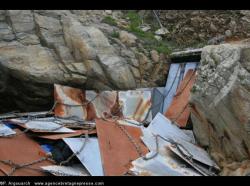 Menez Dregan - Menez Dregan a été occupé plusieurs fois entre - 500.000 et - 300.000 ans par des hominidés, l'homo erectus, qui était un pré-Néanderthalien. On y a découvert des traces de feu et d'habitation qui remontent à environ 465.000 ans. Des plus anciennes au monde et les plus anciennes en Europe. Des chercheurs chinois sont même venus voir le site car ils auraient trouvé eux aussi des foyers trés anciens en Chine. Pas moins de 5 anciens foyers ont été découverts à Menez Dregan. A cause de l'humidité ambiante, aucun ossement de cette époque n'est retrouvé en Bretagne mais dans cette grotte de 50m2 on a découvert des os de grands mammifères et une dent d'éléphant. Les fouilles ont aussi révélé des outils et des pointes de silex provenant de galets de silex comme on en trouve en plusieurs endroits dans la baie d'Audierne. L'effondrement de la voûte de la grotte semble avoir préservé les traces d'occupation que la remontée du niveau de la mer n'a détruites que partiellement.
Menez Dregan - Menez Dregan a été occupé plusieurs fois entre - 500.000 et - 300.000 ans par des hominidés, l'homo erectus, qui était un pré-Néanderthalien. On y a découvert des traces de feu et d'habitation qui remontent à environ 465.000 ans. Des plus anciennes au monde et les plus anciennes en Europe. Des chercheurs chinois sont même venus voir le site car ils auraient trouvé eux aussi des foyers trés anciens en Chine. Pas moins de 5 anciens foyers ont été découverts à Menez Dregan. A cause de l'humidité ambiante, aucun ossement de cette époque n'est retrouvé en Bretagne mais dans cette grotte de 50m2 on a découvert des os de grands mammifères et une dent d'éléphant. Les fouilles ont aussi révélé des outils et des pointes de silex provenant de galets de silex comme on en trouve en plusieurs endroits dans la baie d'Audierne. L'effondrement de la voûte de la grotte semble avoir préservé les traces d'occupation que la remontée du niveau de la mer n'a détruites que partiellement.
http://www.agencebretagnepresse.com/fetch.php?id=26511
BULGARIE – 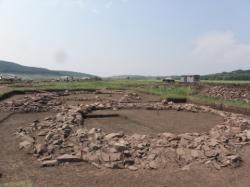 Dren - Archaeologists have uncovered a 2800-year old cemetery during excavations along the route of the future Struma Highway that will link Bulgaria's capital Sofia to the border with Greece. The discovery was made near the village of Dren, Pernik District, by archaeologists from the Regional History Museum in the western Bulgarian city of Pernik. According to the archaeologists, the cemetery preserved the bodies of nobles from Ancient Thrace. The latest finds in a necropolis on the site are dated back to 8-9th century BC. Artifacts from the ancient cremation urns have led the researchers to believe that a number of those buried near the village of Dren were Ancient Thracian warriors.
Dren - Archaeologists have uncovered a 2800-year old cemetery during excavations along the route of the future Struma Highway that will link Bulgaria's capital Sofia to the border with Greece. The discovery was made near the village of Dren, Pernik District, by archaeologists from the Regional History Museum in the western Bulgarian city of Pernik. According to the archaeologists, the cemetery preserved the bodies of nobles from Ancient Thrace. The latest finds in a necropolis on the site are dated back to 8-9th century BC. Artifacts from the ancient cremation urns have led the researchers to believe that a number of those buried near the village of Dren were Ancient Thracian warriors.
http://www.novinite.com/view_news.php?id=140731
USA – 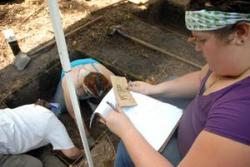 Fort Leavenworth – The original dig found six garbage or burn pits. The 2010 dig found another. In the 2012 dig, they’re finding more items that might tell more stories about the history of people who lived in the area. The team will take back the items to a lab at K-State, where another class will examine the pieces next semester. Digging in the garbage pit, the students found bone fragments, pottery fragments, and stone projectile points. The items are put into paper bags with the locations marked and will be taken back to K-State. There are pieces of the puzzle the young archaeologists do know. Previous carbon dating has shown that people used the Fort Leavenworth site between 250 to 400 A.D., which corresponds with some of the findings. K-State students have found pottery pieces with intricate designs, similar to a group of people known as the Hopewell. The Hopewell were prevalent across the Midwest and eastern part of what is now the United States, and are named for a farm in Ohio where signs of the culture were found in burial mounds there. Archaeologists don’t know what the Hopewell people called themselves. They can identify similar patterns of intricate pottery that link people across the area. The Kansas City Hopewells are the furthest west these people have been found. They likely grew crops, hunted deer and created pottery artwork. Logan said it doesn’t appear they hunted many bison, which were not as dominant here as in some other areas of Kansas. Logan said one of the findings from the 2012 dig might be an arrow point. This could be significant if it pushes the date of the introduction to the bow and arrow to an earlier time. Most of the stone projectile points found at the site are what archaeologists typically call dart points, and Logan said it’s a misconception to call them arrowheads. The dart or spear points predate the bow and arrow, which archaeologists believe was introduced into the Kansas area around 500 A.D. The dart points are too big to shoot from a bow. “With a wide shaft, it just doesn’t make sense,” he said. “It’s not aerodynamically sound.” However, the point the team found on Fort Leavenworth is smaller and could be fired from a bow.
Fort Leavenworth – The original dig found six garbage or burn pits. The 2010 dig found another. In the 2012 dig, they’re finding more items that might tell more stories about the history of people who lived in the area. The team will take back the items to a lab at K-State, where another class will examine the pieces next semester. Digging in the garbage pit, the students found bone fragments, pottery fragments, and stone projectile points. The items are put into paper bags with the locations marked and will be taken back to K-State. There are pieces of the puzzle the young archaeologists do know. Previous carbon dating has shown that people used the Fort Leavenworth site between 250 to 400 A.D., which corresponds with some of the findings. K-State students have found pottery pieces with intricate designs, similar to a group of people known as the Hopewell. The Hopewell were prevalent across the Midwest and eastern part of what is now the United States, and are named for a farm in Ohio where signs of the culture were found in burial mounds there. Archaeologists don’t know what the Hopewell people called themselves. They can identify similar patterns of intricate pottery that link people across the area. The Kansas City Hopewells are the furthest west these people have been found. They likely grew crops, hunted deer and created pottery artwork. Logan said it doesn’t appear they hunted many bison, which were not as dominant here as in some other areas of Kansas. Logan said one of the findings from the 2012 dig might be an arrow point. This could be significant if it pushes the date of the introduction to the bow and arrow to an earlier time. Most of the stone projectile points found at the site are what archaeologists typically call dart points, and Logan said it’s a misconception to call them arrowheads. The dart or spear points predate the bow and arrow, which archaeologists believe was introduced into the Kansas area around 500 A.D. The dart points are too big to shoot from a bow. “With a wide shaft, it just doesn’t make sense,” he said. “It’s not aerodynamically sound.” However, the point the team found on Fort Leavenworth is smaller and could be fired from a bow.
http://www.ftleavenworthlamp.com/features/x1880832605/Archaeology-students-dig-in-to-post-s-past?img=3
TURQUIE – 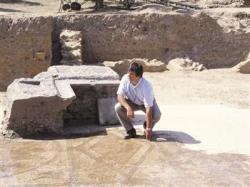 Metropolis - New excavations will begin soon in the ancient city of Metropolis, located within the borders of İzmir’s Torbalı district. Excavations have been jointly carried out in the ancient city for 21 years by the Culture and Tourism Ministry and Trakya University . The head of the archaeology department at Trakya University, Serdar Aybek, said they would continue the excavations of palaestra mosaics and the bath area this year. He said they would make a path for visitors to tour the city more easily, and also planned to reveal all of the palaestra and bath structures this year. Metropolis has been under excavation since 1989. The Classical, Hellenistic, Roman, Byzantine and Ottoman periods are represented in the ancient city.
Metropolis - New excavations will begin soon in the ancient city of Metropolis, located within the borders of İzmir’s Torbalı district. Excavations have been jointly carried out in the ancient city for 21 years by the Culture and Tourism Ministry and Trakya University . The head of the archaeology department at Trakya University, Serdar Aybek, said they would continue the excavations of palaestra mosaics and the bath area this year. He said they would make a path for visitors to tour the city more easily, and also planned to reveal all of the palaestra and bath structures this year. Metropolis has been under excavation since 1989. The Classical, Hellenistic, Roman, Byzantine and Ottoman periods are represented in the ancient city.
http://www.hurriyetdailynews.com/excavations-to-begin-at-ancient-metropolis.aspx?pageID=238&nID=24292&NewsCatID=375
France – 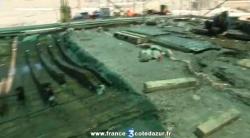 Antibes - Lors d'un chantier de construction d'un parking, des archéologues ont découvert l'épave d'un bateau de commerce romian vieux de 2000 ans et des milleirs d'objets du quotidien. Des objet qui vont permettre de mieux connaîtres les échanges commerciaux en Méditerranée du temps temps des Romains.
Antibes - Lors d'un chantier de construction d'un parking, des archéologues ont découvert l'épave d'un bateau de commerce romian vieux de 2000 ans et des milleirs d'objets du quotidien. Des objet qui vont permettre de mieux connaîtres les échanges commerciaux en Méditerranée du temps temps des Romains.
VIDEO = http://www.youtube.com/watch?v=14VDnjMrK4Q